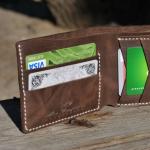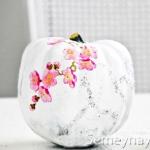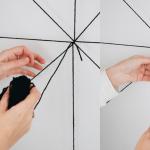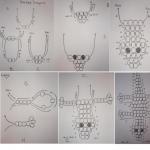New crocheted egg coasters and baskets. Easter egg on a knitted stand Stands for Easter eggs crochet patterns
We bring to your attention an unusual crocheted egg holder. Its originality lies in the fact that it is both a stand and a napkin, albeit a small one. This design makes it possible to tie a truly stable stand that will not roll over with the egg, even if the surface on which we place it is tilted or not completely flat.
I tied two slightly different coasters: in white - 7 sectors, and in blue - 8. I will make a description for the white napkin, and I will attach the diagrams to both - it will be easy to figure it out.
Considering that the knitting density (and the yarn) of our craftswomen will differ from each other, and the size of the egg can be different, during the master class I will describe how to make adjustments so that the egg itself stands well in the basket of the stand.
So, to crochet an egg holder you will need:
acrylic yarn (100 g - 360 m);
hook 3 mm;
an egg - regular or wooden - for trying on a basket.
Crochet egg stand: scheme
The places where we capture only the back or front wall of the columns of the previous row are marked in pink.
The scheme for the white stand is for 7 sectors (the basket is spacious), the description below is drawn up according to this scheme.

Scheme for the blue stand - 8 sectors (the basket is slightly smaller).

Crocheted egg stand: job description
1 row. Around the amigurumi ring - 7 tbsp. without a crochet. Close the row with a blind loop.

2 row. 3 vp lifting + 2 vp, * st. with a yarn over, 2 vp * - repeat from * to * to the end of the row; close the row with a blind loop in the third ch. lifting at the beginning of this row.

3 row. 3 vp lifting, * 3 tbsp. with a yarn around the arch from vp. the previous row, 1 tbsp. with a crochet in a column of the previous row * - repeat from * to * to the end of the row; at the end of the row - 3 tbsp. with a crochet, a blind loop in the third ch. lifting.

We knit a basket. To do this, firstly, we turn knitting so that the front of the columns is outside, and secondly, we knit, grabbing only the upper wall of the columns of the previous row.
4 row. A row of single crochet, close the row with a blind loop. Trying on an egg - the diameter of the knitted basket should be larger than the size of the bottom of the egg.

5 row. 3 vp lifting, a row of double crochet, close the row with a blind loop. Trying on the egg again - this time it should stand firmly in the basket.

6 row. * 2 tbsp. without crochet, picot from 3 vp (3 ch, blind loop in the first ch) * - repeat from * to * to the end of the row. If the egg in such a basket is now dangling, dissolve this row and knit in a different way: ** single crochet with reduction of one loop of the previous row; another 3 tbsp. without crochet, picot ** - repeat from ** to ** to the end of the row and close the row with a blind loop. We fasten the thread, cut it off, and hide the tip on the seamy side of the basket.


We return to knitting the horizontal fabric of the stand. We start knitting at the same point where knitting of the basket began, only now we will grab the remaining lower part of the loop of the columns of the third row.
Let's call the next row 4a.
4a row. It should also be tight, so we will tie it with a row of double crochets. 3 vp lifting, and then we double every second loop, knitting 2 tbsp. with a crochet. We close the row with a blind loop.


5a row. 3 vp lifting, 2 vp, * st. with a crochet in a loop through one, 2 vp * - repeat from * to * to the end of the row, end the row with a blind loop in the third air lifting loop.

6a row. 3 vp lifting, 3 tbsp. with a yarn around the arch from vp. the previous row, * Art. with a crochet in a column of the previous row, 3 tbsp. with a yarn around the next arch from vp. previous row * - repeat from * to * to the end of the row, end the row with a blind loop.

7a row. 3 vp lifting + 4 vp, * st. with a crochet in a loop after 3 tbsp. previous row, ch 4 * - repeat from * to * to the end of the row, end the row with a blind loop in 3 ch. lifting.

8a row. 3 vp lifting + picot, * 4 st. with a yarn around the arch from vp. of the previous row, Art. with a crochet in a column of the previous row, pico * - repeat from * to * to the end of the row, 4 tbsp. with a yarn around the arch from vp. of the previous row, close the row with a blind loop, cut and fasten the thread, and hide the tip inside out.

Steam the finished crocheted stand with an iron (if desired, you can pre-wash it, especially if the yarn is not new or the product is intended for a child) and leave to cool, after which the napkin-basket can be considered ready.






Eva Casio specially for the site
Greetings to my readers. Now the hostesses are preparing with might and main for and I am no exception. I am currently knitting coasters for easter eggs crochet. I really like this kind of jewelry. Such coasters serve as a wonderful decoration, and the testicle itself. Every year I try to come up with something new, and if suddenly the muse does not visit me 🙂, then I use the ideas proposed by other needlewomen on the Internet. For which a huge THANKS to them.
How to crochet an Easter egg holder description
I suggest you knit a testicle stand - a bell.

I attach the diagrams. Below I give a description of the process.
Bell scheme

Leaf scheme

First, we knit a flower.
1. Thread white we collect a chain of 6 vp and close it in a ring. 
2. We do three vp. lifting, then a column with 1 crochet under the chain, * 2 vp, 4 tbsp. with 1 yarn under the chain, * - repeat 4 times (*…. * - repeat a fragment), 2 vp, 2 tbsp. with 1 yarn under the chain and connect with a connecting loop with a column of air loops.

3. Next, we make 2 auxiliary loops over the double crochets of the previous row and begin to knit 3 vp. lifting on a chain of 2 vp. the previous row, 1 tbsp. with 1 yarn over, 2 vp, 2 tbsp. with 1 yarn, * 2 tbsp. with 1 crochet, over the next chain from vp, 2 vp, 2 tbsp. with 1 crochet, * - repeat 5 times, connecting column to column of 3 vp.


4. Knits in the same way as the previous row.


5.2 auxiliary loops over the double crochet of the previous row, vp 3 lifting on a chain of 2 vp. the previous row, 1 tbsp. with 1 yarn over, 2 vp, 2 tbsp. with 1 crochet, * 1 vp, 2 tbsp. with 1 crochet, over the next chain from vp, 2 vp, 2 tbsp. with 1 yarn, * - repeat 5 times, finish connecting post in a column of 3 vp


6. We knit in the same way as the previous one.



7. We knit 2 auxiliary loops over the double crochets of the previous row, 3 vp. lifting on a chain of 2 vp. the previous row, 6 tbsp. with a crochet in a chain of 2 vp, * 3 vp, st. without crochet in VP of the previous row, 3 vp, 7 tbsp. with a crochet over the next chain from vp., * - repeat 5 times, finish with a connecting column to a column of 3 vp., * - repeat 5 times.



How to knit a leaf.
1. Attach the green thread to the bell and tie the first row of the bell st. without a crochet. Moreover, we make the columns on the columns with a crochet of the previous row, between them we make two VPs. It turns out 4 tbsp. without crochet, 2 vp and so on until the end of the row.



2. 3 vp lifting, 3 tbsp. with a crochet in st. without a crochet of the previous row, * 3 vp, 4 tbsp. without crochet, * - repeat 5 times, finish with a connecting column in a column of 3 vp.


3. We knit 2 auxiliary loops over the double crochets of the previous row, 3 vp. lifting on a chain of 3 vp. the previous row, 2 tbsp. with a crochet, 3 vp, 3 tbsp. with a crochet, * 2 vp, 3 tbsp. with a crochet, 3 vp, 3 tbsp. with a crochet, * - repeat 5 times, end with a connecting column in a column of 3 vp.


4. We knit 2 auxiliary loops over the double crochets of the previous row, 3 vp. lifting on a chain of 3 vp. the previous row, 2 tbsp. with a crochet, 3 vp, 3 tbsp. with a crochet, * 2 vp, st. without crochet in the chain of the previous row, 2 vp, 3 tbsp. with a crochet, 3 vp, 3 tbsp. with a crochet, * - repeat 5 times, end with a connecting column in a column of 3 vp.


5. Again we knit 2 auxiliary loops over the double crochet stitches of the previous row, vp 3. lifting on a chain of 3 vp. the previous row, 2 tbsp. with a crochet, 3 vp, 3 tbsp. with a crochet, * 7 vp, st. without a crochet in st. without a crochet of the previous row, 7 vp, 3 tbsp. with a crochet, 3 vp, 3 tbsp. with a crochet, * - repeat 5 times, end with a connecting column in a column of 3 vp.




Crochet egg stand video
Another video how to crochet an egg holder
Crochet patterns and ideas for an Easter egg stand






Such a colorful little thing is most often used as a decor on Easter table or just as a decoration, and how you use it, hurry up to share in the comments.
Today we will knit an egg stand, having examined in detail the scheme and step by step description with photos that will help you quickly figure out knitting.
To create a stand, you will need all kinds of yarn leftovers and a hook number 3. I offer my own knitting pattern, but your number of columns may fluctuate slightly, everything will depend on the thickness of the thread.
Also, get ready to spend a maximum of an hour, and if you have your first knitting skills, then no more than half an hour.
Knitting pattern
1st row: we collect 5 air loops and close them in a ring.
2nd row: we knit with 13 stitches with one crochet.

3rd row: we knit 28 columns with one crochet.
4th row: the motive between the asterisks (* - *) we repeat 6 times
* 3 stitches with 1 crochet, 1 stitch, 3 stitches with 1 crochet, 5 stitches *. 
5 row: we insert the hook through three columns into the air loop and knit the columns, fixing them by the bow of 5 air loops.
I got 12 columns in a petal.
The latter is again fastened in one air loop between three columns. It turns out 6 petals.



6 row: with a contrasting thread we tie the petals with single crochet columns.

7 row: in the circle of the middle of the flower (3 knitted rows) with yarn of a different color, we knit single crochet columns. This will be the base for the egg cup. And then we knit to the desired height, trying on the egg.
I got four rows in blue.
Attention!
When will you do , try not to use chemical dyes - they will stain not only your hands, but also the yarn.


After the cup is ready, we tie its top in white - this is my 5th row of the cup. We knit a flower separately and sew on a stand.
To knit a flower, I used the following scheme. 


I tried to knit the first flower with threads of a dark color, sometimes something didn’t work, I had to tie it up. I advise you to do this too: as long as you figure out the scheme, the threads will not seem old and stale. 

I would like such a do-it-yourself egg stand to please you, your children, or become an excellent gift for family and friends.
I wish you a spring, bright mood before the upcoming holiday and good health!
I saw an egg holder crocheted in this style on the Internet. But I didn't like the way the glass was designed. I had to come up with my own version. I also added some embossing to the cup holder.
For those who prefer to watch the video, a link to the video will be given below.
Materials:
- hook number 1.75;
- yarn of two contrasting colors (I have "Semenovskaya yarn Tenderness", 400 meters in 100 grams);
- scissors;
- starching agent.
How to crochet an egg stand:
We knit a stand in 2 stages. First, we knit a napkin, then add a glass to it on the inner radius.

Cup holder (napkin)
Make a slip loop, secure air loop(vp) and make 2vp. on the rise.
1 row: 15st s1n. in the center of the loop, connecting post (s.s.) in the 3rd century. the beginning of the row.
2nd row: 1v.p. on the rise, * 2st.b.n. in the column of the previous row, 1 st.b.n. in the next. column * - repeat 8 times, st.b.n., close the row with a connecting column (in total, at the end you will get 24 columns in a row).
3rd row: 3v.p. on the rise, 2st.s1n. in the next. column of the previous row, 5v.p. * 2st.s1n. in the second column of the previous row (we skip one), 2st.s1n. in the next. column of the previous row, 5v.p. * - repeat 7 times, st.s1n. in the second column of the previous row (we skip one), s.s. we close the row.
4 row: * 12st.s1n. in the arch from 5v.p., s.s. between two pairs of columns of the previous row * - repeat 8 times.

5 row: tie in a circle with single crochet columns with a contrasting thread, and in the place of the connecting column make a puncture between two pairs of columns of the third row - make a knot, break the thread and hide the tip.
A glass for an egg
1 row: we attach a contrasting thread to the upper loop of the single crochet from the second row (photo 6) and tie around the free loops in a circle st.b.n. - only 24 columns (photo 7).
2nd row: 3 vp on the rise, * 2st.s1n. one in each column of the previous row, 2st.s1n. in every third column of the previous row * - knit in a circle, at the end of the row do s.s. in the 3rd century the beginning of the row. In total, there should be 32 columns in the second row of the middle (photo 8).

3rd row: 1v.p. on the rise, alternate * 2st.b.n., 2st.b.n. * - one column in each column of the previous row. We finish the row with a connecting column in an air loop that starts the row (Photo: How to crochet an egg holder part 3).

4th row: change the thread, 1v.p. on the rise, * in each st.b.n. of the previous row we knit 1 st.b.n., in each st.s1n. knit the previous row 2st.s1n *. We finish the row with a connecting post in an air loop that starts the row. At the end we make a knot, cut the thread and hide the tail.
To make the egg stand stand more reliable, you need to starch it well, straighten it and dry it.
Shared a master class
Anastasia Kononenko





